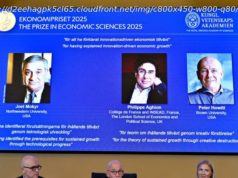 The Doomsday Clock has inched closer to and farther from nuclear Armageddon since the Manhattan Project in 1947. On Thursday, the clock moved closer to Midnight — the closest it has been since 1954.
The Doomsday Clock has inched closer to and farther from nuclear Armageddon since the Manhattan Project in 1947. On Thursday, the clock moved closer to Midnight — the closest it has been since 1954.
MICHEL MARTIN, HOST:
We try to present the sweet with the bitter, which is another way of saying the news is not all doom and gloom. But we’re going to really lay into the doom part for the next few minutes because on Thursday, the world ticked half a step closer to Armageddon – that at least according to the Bulletin of the Atomic Scientists and the Doomsday Clock. Every year since 1947, a board of scientists has considered the year’s developments in politics, energy, weapons, diplomacy and climate science. They determine how imminent the end of civilization appears to be with the end visualized as midnight on a clock. For the last two years, the clock has been set at three minutes to midnight. But this week, the clock moved to two and a half minutes to midnight.
Here to talk about that decision and all that goes into it is Lawrence Krauss. He’s a theoretical physicist at Arizona State University. He’s a prolific science writer, who often weighs in on public policy issues. And he is chairman of the board of the Bulletin of Atomic Scientists, which decides the Doomsday Clock. And he’s with us now. Thank you so much for joining us.
LAWRENCE KRAUSS: It’s great to be with you virtually.
MARTIN: So what are the factors that went into deciding to move the clock this year?
KRAUSS: Well, as usual, we look at many different factors from the likelihood of nuclear war, the tensions around the world through climate change and even looking at new emerging technologies. When it comes to nuclear weapons, in the last year, there’s been a lot of saber-rattling, in particular a lot of irresponsible statements from the new president of the United States, but equally vitriolic statements, in some sense, by the president of Russia as well.
There is the fact that we haven’t moved towards reduction of nuclear weapons and there, in fact, has been discussion of the possible increase in nuclear weapons, at a time when, in fact, we signed a treaty many years ago called the Non-Proliferation Treaty, which not only required other nations not to obtain nuclear weapons but the nuclear nations to try and disarm. And we’re essentially violating that treaty.
MARTIN: When was the last time the Doomsday Clock was this close to midnight?
KRAUSS: It’s been 64 years. The last time the clock was closer than this was in 1953 when the then-Soviet Union exploded its huge hydrogen bomb for the first time. And that really began the modern arms race. And so in the lifetime of many of the people listening to you and me today, the clock has never been closer. And that certainly is a cause for concern.
MARTIN: Now, we should mention that the clock has moved further from midnight. In 2010, for example, it moved from five to six minutes. But that’s what leads me to ask you – you know, if you ask many Americans of a certain age, especially people who live through it, the closest that they remember the world coming to nuclear catastrophe was in 1962 during the Cuban missile…
KRAUSS: Yeah.
MARTIN: … Crisis. But that year, the clock stood at seven minutes to midnight. The year after that it moved to 12 minutes to midnight. So why are we so much closer to midnight in the Doomsday Clock than in a year when school kids were doing duck-and-cover drills in class?
KRAUSS: (Laughter) Let me just say, first of all, we try not to respond to individual events. We try and take a global view. And so the Cuban Missile Crisis, the group at that time felt that their concerns about nuclear weapons were existing before that and they didn’t want to move it in response to a crisis that had passed.
But what’s important with the clock is not so much its absolute position as much as which direction it’s going. And so if we’re going to step back from the brink, be it nuclear weapons or climate change, it won’t happen unless the public tries to push leaders in the right direction.
MARTIN: Well, you know, that really leads me to my final question. Are you concerned at all that moving the clock so soon after the election of Donald Trump will cause many Americans who already have a very polarized view of politics to view this as yet another partisan attack, at least to his supporters to view this as part of a partisan attack? Are you at all concerned about that?
KRAUSS: Well, yeah, I’m concerned. But the important thing is the clock has always been moved in January. We try, as I say, to make our statements in response to the developments of the world over that year. And like it or not, the statements that he has made, in particular about expanding our nuclear weapons systems of potentially having a new arms race, potentially using nuclear weapons and encouraging other countries from Japan to South Korea to get their own nuclear weapons, are very disturbing.
MARTIN: Professor Krauss, thank you so much for joining us.
KRAUSS: It’s been a pleasure as always. Thanks.
MARTIN: That was Lawrence Krauss. He is a theoretical physicist and chairman of the board of the Bulletin of the Atomic Scientists, which sets the Doomsday Clock. He is also a science writer and author. His latest book « The Greatest Story Ever Told – So Far » comes out this March.
Copyright © 2017 NPR. All rights reserved. Visit our website terms of use and permissions pages at www.npr.org for further information.
NPR transcripts are created on a rush deadline by Verb8tm, Inc. , an NPR contractor, and produced using a proprietary transcription process developed with NPR. This text may not be in its final form and may be updated or revised in the future.






![14 października – Dzień Edukacji Narodowej [SONDA]](http://nhub.news/wp-content/uploads/2025/10/thumba03e36741786e984a7a60fedd5b57836-100x75.jpeg)